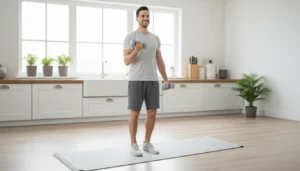How Physical Activity Can Help with Weight Control

Introduction
Did you know that just 30 minutes of moderate physical activity a day can significantly reduce your risk of weight gain? According to the Centers for Disease Control and Prevention (CDC), engaging in regular physical activity not only helps manage your weight but also enhances your overall health and well-being. As we navigate through a world increasingly influenced by sedentary lifestyles and processed foods, understanding the role of physical activity in weight control has never been more critical.
At TrimRx, we believe in empowering individuals to adopt healthier lifestyles through a combination of innovative telehealth solutions and personalized weight loss programs. Our journey began with a vision to merge cutting-edge technology with effective weight management strategies, emphasizing the importance of individualized care. In this blog post, we will explore how physical activity contributes to weight control, the various types of exercise, and practical tips for incorporating movement into your daily life.
By the end of this article, you will have a comprehensive understanding of how physical activity can help you achieve and maintain your weight goals, as well as gain insights into our personalized weight loss solutions that can support your journey. We'll also highlight the importance of combining exercise with a balanced diet and how TrimRx’s supportive environment can assist you every step of the way.
The Connection Between Physical Activity and Weight Control
The fundamental principle behind weight control is the balance between the calories you consume and the calories you expend. When we engage in physical activity, our bodies burn calories. The more intense the exercise, the more calories we burn. This leads to a calorie deficit, which is essential for weight loss.
Energy Expenditure and Caloric Balance
To maintain a healthy weight, it's crucial to understand the concept of energy balance. This is the relationship between energy intake (calories consumed) and energy expenditure (calories burned). When we consume more calories than we burn, we gain weight, while burning more calories than we consume leads to weight loss. Physical activity increases energy expenditure, making it a vital component of any weight management strategy.
Research suggests that regular physical activity not only aids in weight loss but also helps maintain weight loss over time. A study published in the American Journal of Clinical Nutrition found that individuals who engaged in regular physical activity were more successful in keeping the weight off compared to those who relied solely on dietary changes. This underscores the importance of incorporating exercise into your daily routine.
The Role of Exercise in Weight Loss
While dietary changes are crucial for losing weight, exercise plays a significant role in the process. Engaging in regular physical activity can help you create and maintain a calorie deficit. According to the 2020-2025 Dietary Guidelines for Americans, adults should aim for at least 150 minutes of moderate-intensity aerobic activity each week, along with muscle-strengthening activities on two or more days a week.
Types of Physical Activity
There are various types of physical activities that can aid in weight control:
- Aerobic Exercise: Activities like walking, jogging, cycling, and swimming increase heart rate and promote calorie burning. Moderate-intensity aerobic exercise can be as simple as brisk walking for 30 minutes a day.
- Strength Training: Incorporating weight lifting or bodyweight exercises not only helps build muscle but also increases your resting metabolic rate. Muscle tissue burns more calories at rest compared to fat tissue.
- Flexibility and Balance Exercises: Yoga and Pilates can enhance overall fitness levels and promote mindfulness, which can be beneficial in managing stress-related eating.
- Daily Activities: Small changes, such as taking the stairs instead of the elevator or walking during breaks, can contribute to your overall physical activity levels.
Summary of Key Points
- Physical activity leads to increased energy expenditure, creating a calorie deficit essential for weight loss.
- Regular exercise helps maintain weight loss over time.
- A balanced approach that includes aerobic exercise, strength training, and daily activities is most effective for weight control.
How Much Physical Activity Do You Need?
The amount of physical activity required for effective weight control varies from person to person. While the general recommendation is at least 150 minutes of moderate-intensity exercise per week, some individuals may need more to achieve their weight loss goals.
Understanding Exercise Intensity
It's essential to differentiate between moderate and vigorous-intensity exercises:
- Moderate-Intensity Activity: This includes activities such as brisk walking, leisurely cycling, or dancing, where your heart rate increases but you can still hold a conversation.
- Vigorous-Intensity Activity: This includes running, swimming laps, or participating in high-intensity group classes, where your heart rate is significantly elevated, and conversing becomes challenging.
Guidelines for Different Goals
- For Weight Loss: Increasing the amount of physical activity to 300 minutes per week can enhance weight loss efforts. This can be achieved through a mix of moderate and vigorous activities.
- For Weight Maintenance: To maintain weight loss, it's recommended to engage in regular physical activity, ideally aiming for 150 to 300 minutes per week.
Individual Considerations
It's important to consider individual factors such as age, fitness level, and any underlying health conditions when determining your physical activity goals. For personalized guidance, we encourage you to take our free assessment quiz at TrimRx. This will help us understand your needs and develop a tailored plan that fits your lifestyle and weight loss objectives.
Start your free assessment quiz here!
Incorporating Physical Activity into Your Daily Routine
Adopting a more active lifestyle doesn't have to be overwhelming. Here are some practical tips for incorporating physical activity into your daily routine:
Set Achievable Goals
Start by setting realistic and specific goals. Instead of aiming to exercise for an hour every day, begin with small, manageable targets. For example, aim for 10 minutes of walking after meals or 15 minutes of strength training three times a week. Gradually increase your goals as you become more comfortable.
Find Activities You Enjoy
Choosing activities that you enjoy will make it easier to stick to your routine. Whether it's dancing, hiking, cycling, or group classes, find something that excites you. This can make physical activity feel less like a chore and more like a fun part of your day.
Make Movement Part of Your Day
Incorporate movement into your daily life by:
- Taking the stairs instead of the elevator.
- Parking farther away from entrances to get extra steps in.
- Walking or biking to work if feasible.
- Scheduling active breaks during work hours, such as short walks or stretching sessions.
Use Technology for Motivation
Consider using fitness apps or wearable devices to track your activity levels. This can provide motivation and help you stay accountable to your goals. Many apps also offer community support and challenges to keep you engaged.
Listen to Your Body
Pay attention to how your body feels during and after exercise. If you experience pain or discomfort, modify your activities or consult a healthcare professional. It's important to find a balance that works for you without risking injury.
Summary of Key Points
- Set realistic and specific goals to make physical activity manageable.
- Choose enjoyable activities to enhance adherence to your routine.
- Incorporate movement into daily life through simple changes.
- Use technology for motivation and accountability.
The Benefits of Regular Physical Activity Beyond Weight Control
While weight management is a primary focus, the benefits of regular physical activity extend far beyond the scale. Engaging in regular exercise can lead to numerous health benefits, including:
- Improved Mental Health: Physical activity has been linked to reduced symptoms of anxiety and depression. Exercise releases endorphins, which are natural mood lifters.
- Enhanced Cognitive Function: Regular movement can improve brain health and cognitive function, helping you stay sharp as you age.
- Better Sleep Quality: Active individuals often experience improved sleep patterns, allowing for better rest and recovery.
- Stronger Bones and Muscles: Weight-bearing exercises help maintain bone density and muscle strength, reducing the risk of osteoporosis and sarcopenia as we age.
- Reduced Risk of Chronic Diseases: Regular physical activity can lower the risk of conditions such as heart disease, diabetes, and certain cancers.
- Increased Longevity: Studies have shown that physically active individuals tend to live longer and enjoy a higher quality of life.
Summary of Key Points
- Regular physical activity contributes to improved mental health, cognitive function, and sleep quality.
- Exercise promotes stronger bones and muscles while reducing the risk of chronic diseases.
- An active lifestyle is linked to increased longevity and quality of life.
How TrimRx Can Support Your Weight Control Journey
At TrimRx, we understand that each individual's weight loss journey is unique. Our approach combines advanced medical science with personalized care to create a supportive environment for sustainable weight loss. Our services include:
- Personalized Weight Loss Programs: We offer a range of prescription medications, including compounded Semaglutide and Tirzepatide, tailored to your specific needs. By taking our free assessment quiz, you can determine your eligibility for these medications and receive a personalized treatment plan.
- Comprehensive Support: Our services include doctor consultations, lab work, and unlimited support to guide you through your weight loss journey. We're here to provide the resources and encouragement you need to succeed.
- Quick-Access Supplements: Supplement your weight loss efforts with our GLP-1 Daily Support and Weight Loss Boost. These products are designed to enhance your overall wellness and support your journey toward a healthier lifestyle.
Explore our GLP-1 Daily Support here!
Check out our Weight Loss Boost here!
Conclusion
Physical activity is a vital component of weight control, contributing to both weight loss and maintenance efforts. By understanding the connection between exercise and caloric balance, setting achievable goals, and incorporating movement into our daily lives, we can create healthier habits that last a lifetime.
At TrimRx, we are dedicated to helping you achieve your weight loss goals through personalized, medically supervised solutions. By combining exercise with our innovative programs, you can take charge of your health and embrace a lifestyle that fosters long-term success.
As you reflect on your own weight control journey, consider how physical activity can play a pivotal role in your success. Are you ready to take the first step?
FAQ
How much physical activity should I do each week to manage my weight?
Adults should aim for at least 150 minutes of moderate-intensity aerobic activity per week, combined with muscle-strengthening activities on two days.
Can I lose weight by exercising alone?
While exercise helps create a calorie deficit, it is most effective when combined with dietary changes. A balanced approach is crucial for sustainable weight loss.
What types of exercise are most effective for weight loss?
Both aerobic and strength training exercises are effective for weight loss. Incorporating a mix of both can yield the best results.
What should I do if I experience pain during exercise?
If you experience pain, stop the activity and consult a healthcare professional. It’s essential to listen to your body and adjust your routine as needed.
How can TrimRx help me with my weight loss journey?
TrimRx offers personalized weight loss programs, prescription medications, comprehensive support, and quick-access supplements tailored to your individual needs. Take our free assessment quiz to learn more about how we can assist you.

Transforming Lives, One Step at a Time
Keep reading
Managing Hormones for Weight Loss: A Comprehensive Guide to Rebalancing Your Body
Struggling to lose weight? Discover how managing hormones for weight loss can transform your journey. Learn about key hormones & personalized solutions.
Can We Eat Dark Chocolate in Weight Loss? Exploring the Facts
Wondering can we eat dark chocolate in weight loss? Discover how to enjoy this treat while staying on track with your diet. Learn more now!
Can We Eat Curd During Weight Loss?
Wondering if we can eat curd during weight loss? Discover its benefits, how to incorporate it into your diet, and debunk common myths!



